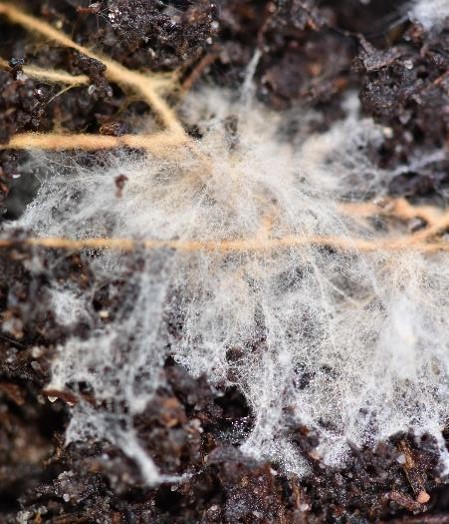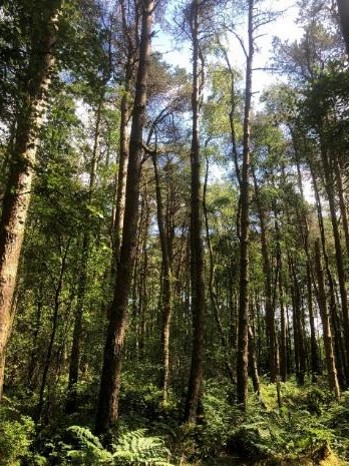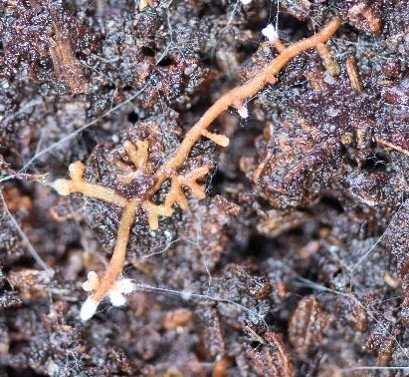Summary
Overview
There is compelling evidence (mostly from semi-arid regions) that ectomycorrhizal fungi (EMF) can play a critical role in drought tolerance. Some species of mycorrhizal fungi form common mycorrhizal networks (CMN) between individual trees of the same species, or even among species of widely different phylogenies. Tree species that host EMF species and readily form CMNs potentially improve the resistance and resilience of co-occurring tree species to drought by facilitating the mobilisation of key water resources between individual trees. But it is unknown how tree species and drought conditions interact to alter the formation of CMNs and what effect this has on tree resistance to drought in single and mixed tree species woodlands.
In addition to the potential to help improve tree drought tolerance, mycorrhizas are known to play a key role in forest decomposition pathways. Less well understood, is the relative importance of EMF compared with saprotrophic (decomposer) fungi on rates of decomposition in single and mixed species stands and how decomposer communities and decomposition rates might vary considering the tree species present. Different rates of decomposition have an important influence on levels of soil carbon and nutrient cycling, with feedback loops influencing tree growth rates.
The outcomes of this research will provide valuable insights for forest management, offering evidence-based guidelines for creating drought-resilient, productive woodlands, thereby supporting climate change adaptation and mitigation efforts.
This project is part of the Nature for Climate Fund.

Research Objectives
- Investigate how EMF communities might help forests resist and recover from drought, focusing on mixtures where at least one tree species forms common mycorrhizal networks (CMNs), such as Suillus spp. with Scots pine.
- Examine how tree species composition (monocultures vs. mixtures) and drought risk affect communities of EMF, soil invertebrate decomposers, fungal saprotrophs, tree/soil carbon and nutrient balances and tree growth.

Research Questions
- What role do CMNs play in helping trees withstand and recover from drought in both single and mixed species stands of Scots pine and birch?
- Are there notable differences in EMF, soil invertebrates, and saprotrophic fungal communities between single and mixed species stands of Scots pine and birch?
- What is the effect of water availability on ectomycorrhizal community composition, and how is this modulated by forest stand composition?
- Do any differences in EMF and saprotrophic fungal communities between single and mixed species stands significantly affect carbon and nutrient balances both below and above ground?

Latest Update
Large-scale Sample Collection
Single tree species stands and mixtures of Scots pine and birch have been sampled in England covering an area with a breadth of risk of drought. Fieldwork for collecting soil samples from these plots is ongoing, with samples undergoing laboratory analysis and processing.
Microcosm Experiments
Drought microcosm experiments have been set up in the greenhouse to assess the role of Common Mycorrhizal Network (CMN) formation on levels of tolerance to drought in single and in mixed tree species contexts.
Long-term Mixture Experiment Trials
- Drought treatment effects: Fungal communities in single and mixed species experimental stands subjected to water addition or no water addition (drought) treatments have been sampled in early autumn 2024. The community composition and the relative abundance of saprotrophic and ectomycorrhizal fungi in each treatment will be assessed and related to tree growth.
- Decomposition rates: We are also conducting experiments to quantify the role of soil fungi to belowground and aboveground carbon and nutrient balances, involving both long term single and tree species mixture trials (e.g. Hambledon Scots pine and birch mixture in central England).
Laboratory simulations
Preliminary experimental work in the lab is underway to examine the ecological interactions between soil fungal groups to identify the factors driving competition and decomposition. The findings will contribute to carbon accounting models and inform forestry management strategies to create resilient and productive forests with enhanced carbon sequestration.

Downloads
Funding & Partners
- This project has been funded through the Government's ‘ Nature for Climate Fund’
-
 DEFRA
DEFRA - Collaborating Partners
-
 Natural England
Natural England -
 Forestry Commission
Forestry Commission -
 The University of Manchester
The University of Manchester -
 University of Reading
University of Reading
